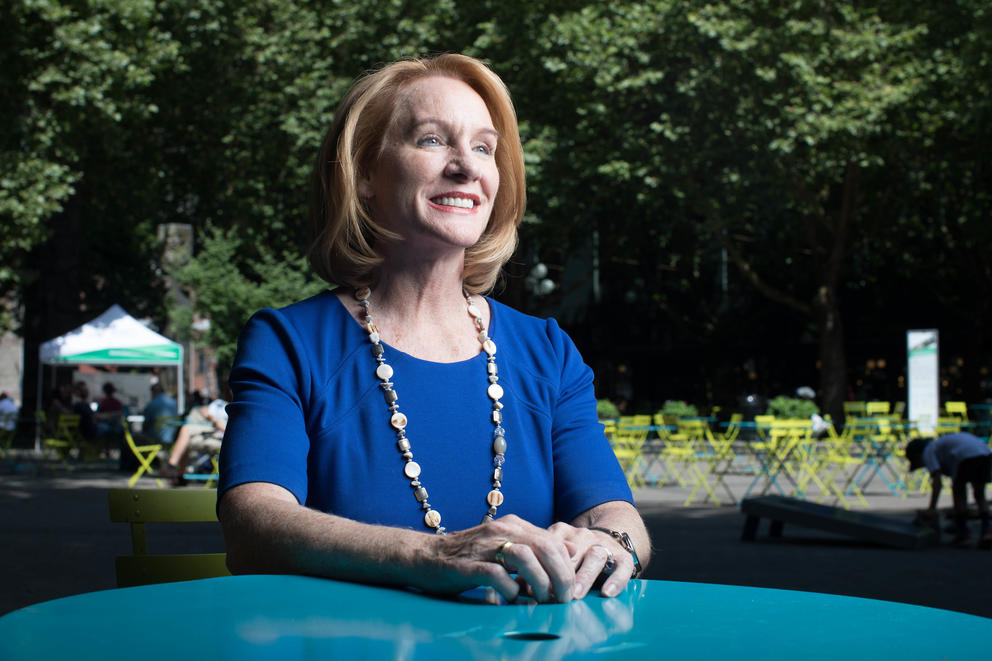The view is good, too, because there is unfinished business across the street: a city block that is an empty hole in the ground. It tempts the imagination. At some point it likely will be a view-blocking high-rise, but it would make a great place for a public plaza: just imagine the vigils, demonstrations and encampments!
The current view has particular meaning for the mayor, Jenny Durkan, who is a local native. Her father, Martin, was a prominent attorney, legislator and gubernatorial candidate and used to take his kids to trials at the county courthouse across the way. Her maternal grandfather, Dominic “Dan” Noonan, worked for the Alaska Steamship Co. and lived at the Arctic Club. Durkan herself worked in some of the close-by office buildings, including Pacific Place and the Central Building. For her it’s a tableau of personal history, but it also reflects some of the mayor’s challenges ahead.
In a recent brief conversation in her office, the usually fast-paced mayor is slowed from knee surgery. Her braced leg needs to be elevated when she sits, and a staff member jokes that they can finally keep up with her. But the city isn’t slowing down.
City staffers are happy that the worst-case scenarios of phase one of the “Seattle Squeeze” did not become a total nightmare, and the opening of the waterfront tunnel has gone well thus far. They also survived the snows of last month, knowing that snow events can and have helped bring down a mayor. But they are bracing for what they call “Chapter Two” of transportation challenges. On March 23, 823 buses will be purged from the downtown “bus” tunnel and moved onto city streets. The occasion is the Washington State Convention Center expansion and preparing the tunnel for more trains.
If you think downtown congestion is a headache now, just wait. The period of change and adjustment is long — the “period of maximum constraint” is slated to be four or five years of transportation tumult resulting from many big projects and continuing development. Managing that is a big part of Durkan’s job.
I asked her what one thing she has learned about Seattle that she didn’t know when she started as mayor. Until she was campaigning for mayor, she says she didn’t “anticipate how deep the anxiety and fear about growth was.” When she would speak to audiences and talk about growth, she has asked people to raise their hands if they wanted the city to “hit pause,” and every hand would go up, she says. She recognizes that Seattleites are traditionally skeptical people. “We’ve always been a bit of a naysayer region,” she says. But “we cannot be fearful of the future.”
Durkan sees that future as very bright. That open view from City Hall? That is what the coming waterfront could be like: views for everyone. “We have an opportunity to mold a better Seattle,” she says. She believes some people underestimate the impact of the waterfront makeover: it will be transformative, she says. Roger Sale, the late author of Seattle Past to Present, wrote in 1976 that the redevelopment of the land between the waterfront and First Avenue — messed up first by the railroads and later by highway engineers — would be a huge boost to the city, and all it would take was a “spurt” of energy to take the Alaskan Way Viaduct down.
That is now happening, though we’re experiencing much more than a spurt 40 years later. Durkan believes the new waterfront will be a win for many reasons, but reopening the city to Elliott Bay and Puget Sound, eliminating the noise and bringing in daylight will be major enhancements alone. Go to the new section of the Pike Place Market and “stand on the precipice” of the new overlook to get a hint of what the new waterfront will be like, she says. On a recent post-snow Sunday the crowds there were at a summertime pitch. She ticks off benefits: It’ll be great for public access — people will be able to walk all the way to Interbay when it’s done; the maritime industry and heritage will get a boost; it will be a great gathering space. “The waterfront,” she predicts, “will be a global destination.”
Given the skepticism of “naysaying” Seattle, Durkan remains extremely positive about where the city will wind up after all the remodeling mess is through: more light rail connecting the city, more tech-sector growth, a reinvigorated waterfront. She remembers the burst of civic effort that followed the Seattle World’s Fair in 1962. Durkan says she attended Paul Allen’s memorial service where it was mentioned how inspired Allen was by the fair he attended in his youth. It inspired Allen and Seattle to think of Seattle as a city of the future — to think big. “We are going to be doing civic projects on that scale,” she says. It’ll be worth it.
“If we get it right, it could be Seattle’s golden years,” Durkan says.
Nothing less might be required to quiet the skeptics and reward the inconvenienced.

Get daily news in your inbox
This newsletter curates some of the most important headlines of the day from Crosscut and other news outlets.





